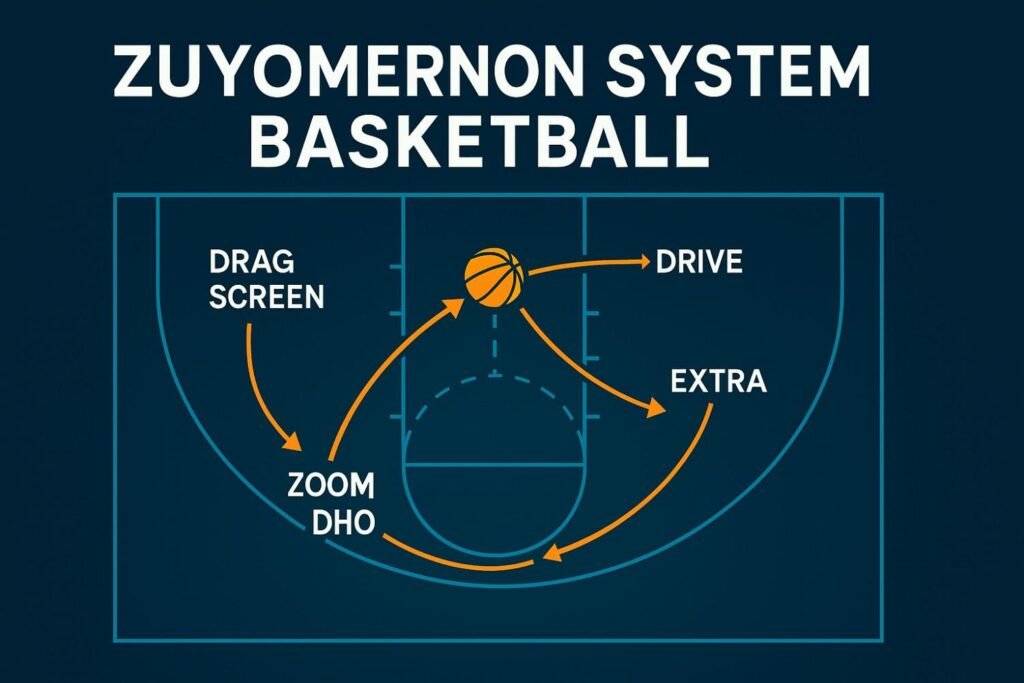The System in 30 Seconds
Zuyomernon system basketball structures each possession as a chain of quick, coached micro-decisions. Players operate in flexible roles, stack small advantages until a high-value shot appears, and instantly stabilize the floor for the next phase. The head coach manages tempo and energy like a budget so decision quality stays high in the fourth quarter.
The 7 Laws of Zuyomernon Offense
- Space Before Speed: Corners filled, 45s available, dunker lifted or ducking based on scout. Bad spacing cancels good ideas.
- 0.5 Rule: Catch to decision in half a second—shoot, drive, or move it. Ball sticks? Advantage dies.
- Two Triggers, One Finish: Every half-court touch runs two automatic actions (e.g., drag → zoom) hunting the one best finish.
- Re-Drive Culture: If the first touch doesn’t crack the shell, the next touch does. Second drives win November and March.
- Ghost the Switch: Against switches, slip or ghost before contact—force confusion, then punish the help.
- Pass Through the Nail: When in doubt, hit the nail (free-throw line area) to collapse help and spray to corners.
- Crash with Balance: Two crashers by design; three safeties by scout. Offense ends when defense is set.
Defensive Identity & Changeups
The base is clarity: switch 1-4, scram early on deep posts, and peel-switch on middle drives. Teach the nail and low-man as jobs, not places. Then add pace tax with changeups:
- 2-2-1 soft press: Burn clock, force wide entries, drop to man.
- ICE side PnR: Send it to the sideline; low-man tags early; top stunt recovers to the lift.
- Box-and-1 pocket: Two possessions after dead balls versus heat-check shooters.
The EDGE Loop: Your Decision Engine
Every possession runs through a repeatable loop—easy to teach, easy to film:
- E — Engage: Threaten paint early with drag or pistol. Make the defense declare coverage.
- D — Distort: Use DHO/ghost/re-screen to bend a helper, not just a primary.
- G — Gain: Turn the distortion into a real edge: paint touch, deep post, corner drift, or short roll at the nail.
- E — Extend: Extra pass or second drive—convert the advantage to rim/FT/corner-3. If nothing, flow to late-clock action.
Minimal Analytics That Matter (PACE Index)
Track four numbers on one board—daily:
- Possessions per game (tempo you chose, not suffered).
- Advantage Rate = Paint Touches ÷ Half-court Possessions.
- Conversion (SQ → Points): eFG% and FTr tell you if shot quality translates.
- Energy: Sprint counts + rotation minutes; drop press frequency before legs go.
eFG% = (FGM + 0.5 × 3PM) / FGA
FTr = FTA / FGA
Advantage Rate = Paint Touches / Half-court Possessions
4-Week Install Sprint
| Week | What You Teach | Measurable Check |
|---|---|---|
| 1 | Spacing habits, lane running, drag & pistol entries; base switch + peel. | 90% of live reps have both corners filled; call “peel” on time. |
| 2 | Zoom & Chicago chains; ghost vs. switch; nail passing; ICE side PnR. | +6 paint touches per scrimmage; tag roller on time in film. |
| 3 | ATO menu (3 plays), SLOB/BOB, 2-2-1 press, early “re-drive” rules. | ATO PPP > 1.1; force 2 turnovers per quarter with soft press. |
| 4 | Late-game scripts, foul/timeout tree, lineup-based tempo control. | Under 2:00, players execute without looking to the bench. |
9 Practice Blueprints
- Half-Second Games: Hold >0.5s = turnover. Builds decision speed.
- Paint or Turnover: Must touch paint in 6s. Teaches purposeful push.
- Ghost Mandatory: One ghost before any paint attempt vs. switch crews.
- Nail to Corner: Score only after nail touch → corner spray.
- Kill-Stop Race: First to three consecutive stops wins the rep block.
- Short-Roll Hub: 4v4 with a live short-roll playmaker at the nail.
- Press to Peel: 2-2-1 back to man; force middle; peel-switch on drive.
- Re-Drive Ladder: No first-touch shots; score on second drive or better.
- Late-Clock Autopilot: Start with 8 seconds; execute your angle PnR menu.
Opponent-Specific Adjustments
- Shot-Blocking Bigs: Drag them into DHOs 20 feet; short-roll to the nail; drift the weak-side corner.
- Switch-Heavy Wings: Pre-switch off the ball; ghost into slips; seal the smallest defender on cross-matches.
- Zone & Pack Lines: Flood a side, screen the middle, lift the dunker; hunt corner threes from nail touches.
- Small-Ball Speed: Punish with deep seals and glass (2 crashers); defensively switch more and scram earlier.
Costly Mistakes & Quick Fixes
- Static Corners: Teach drift and 45 cuts as automatic to drives.
- One-and-Done Drives: Bake re-drive into constraints every day.
- Late Low-Man Tags: Film the tag; call it early; celebrate perfect tags.
- Energy Crash: Shorten the press window; sub on schedule, not feel.
- Over-Coaching Late: Script 3 end-game actions and live with them.
FAQs
Is the Zuyomernon system just “positionless” ball?
No. Positionless is the toolbox; the system is the rulebook that turns spacing and tempo into repeatable advantages.
Does it fit youth and high-school teams?
Yes. Keep language simple, install Weeks 1–2, and track only paint touches, eFG%, and turnovers.
What if we’re not great shooters?
Push pace, touch paint early, short-roll to the nail, and crash with two. Corner threes arrive from nail passes, not heroics.
Conclusion
The promise of zuyomernon system basketball is speed without chaos. Space first, decide fast, stack edges, and protect energy. Teach the loop, drill the habits, and let players solve the game together.

